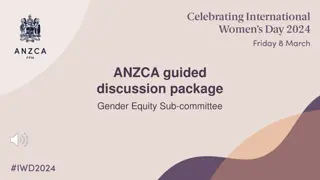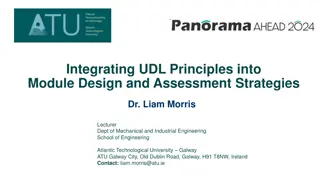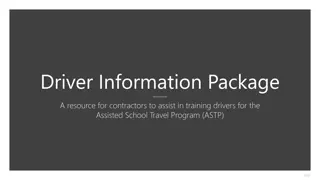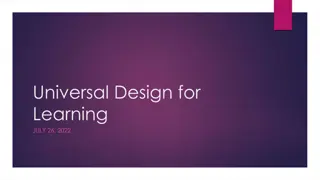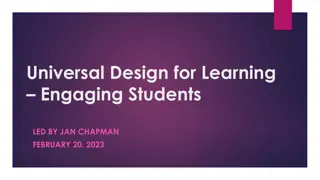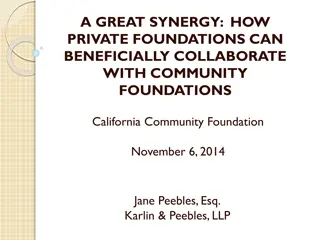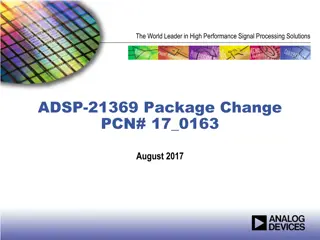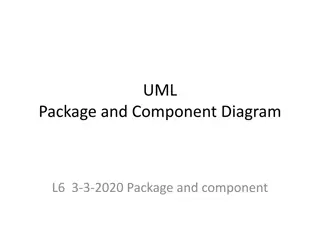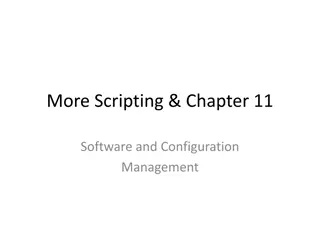Foundations of UDL Resource Package Overview
Universal Design for Learning (UDL) is a framework for creating inclusive, equitable, and accessible learning environments. This resource package provides foundational information on UDL in a higher education context, examples of UDL at Mohawk College, and additional resources for further learning. Explore the purpose, overview, and guidelines of UDL, along with the goal of developing expert learners through multiple means of engagement, representation, and action. Watch the UDL with CTL video to understand how UDL Guidelines apply at Mohawk College.
Download Presentation

Please find below an Image/Link to download the presentation.
The content on the website is provided AS IS for your information and personal use only. It may not be sold, licensed, or shared on other websites without obtaining consent from the author.If you encounter any issues during the download, it is possible that the publisher has removed the file from their server.
You are allowed to download the files provided on this website for personal or commercial use, subject to the condition that they are used lawfully. All files are the property of their respective owners.
The content on the website is provided AS IS for your information and personal use only. It may not be sold, licensed, or shared on other websites without obtaining consent from the author.
E N D
Presentation Transcript
Foundations of UDL Resource Package Darla Benton Kearney Teaching & Learning Consultant UDL Centre for Teaching & Learning
Why UDL? Universal Design for Learning (UDL) is a curriculum design, development, and delivery framework used to create inclusive, equitable and accessible learning environments. Mohawk College is committed to UDL implementation to support our Equity, Diversity and Inclusion (EDI) targets and institutional accessibility goals.
Purpose The information in this resource package will: Provide you with foundational UDL information for a higher education context. Offer you examples of UDL at Mohawk College. Provide you with resources to learn more about UDL when are able.
UDL with CTL The UDL with CTL video can be found on Mohawk College s UDL landing page. Screenshot of the UDL with CTL Video Screenshot of the UDL with CTL video, which can be found on Mohawk College's UDL landing page (https://www.mohawkcollege.ca/employees/centre-for-teaching-learning/universal-design-for-learning). Using the link provided, watch the video to learn about the UDL Guidelines and how they apply at Mohawk College [6:09].
Overview of UDL | Goal The goal of UDL is to develop masterful learners who are purposeful, motivated, resourceful, knowledgeable, strategic, and goal-directed. Each network is focused on supporting the development of expert learning. The next slides offer a text explanation of the UDL Guidelines, as well as a graphic of the UDL Guidelines used at Mohawk College.
Overview of UDL | Guidelines UDL guidelines are based on three primary brain networks: Affective Recognition Strategic Each network is identified by a principle to guide curriculum design, development, and delivery: Multiple means of engagement the why of learning Multiple means of representation the what of learning Multiple means of action and expression the how of learning
Overview of UDL | Guidelines Multiple means of engagement Options for self-regulation Options for sustaining effort and persistence Options for recruiting interest Each network is supported by checkpoints to encourage the development of teaching and learning options. Multiple means of representation Options for comprehension Options for language, math and symbols Options for perception Multiple means of action and expression Options for executive functions Options for expression and communication Options for physical action
UDL Guidelines Recognition Networks Affective Networks Strategic Networks The why of learning The what of learning The how of learning Multiple Means of Engagement Multiple Means of Representation Multiple Means of Action and Expression Provide options for expression and communica- tion Provide options for sustaining effort and persistence Provide options for recruiting interest Provide options for self regulation Provide options for language and symbols Provide options for comprehend- sion Provide options for physical action Provide options for executive functions Provide options for perception
UDL in Action If UDL is new to you, it can be difficult to visualize what it might look like in your context. The following slide provides a number of practical examples of UDL in higher education. When thinking about UDL, please keep in mind that adding UDL to your curriculum does not need to be a massive undertaking or involve time consuming elements. For implementation ideas, review Mohawk College s UDL Implementation webpage.
UDL Examples Multiple Means of Engagement Multiple Means of Representation Multiple Means of Action and Expression Explicitly state learning goals and/or expectations. Provide content in multiple ways. Develop an agenda or learning plan and follow it. Employ interactive learning activities. Provide access to resources to deepen learning. Provide note taking support. Give opportunities to collaborate. Use multimedia resources to deliver content. Include a variety of communication options. Link new information to previously learned content or experiences. Offer opportunities for reflection. Offer opportunities to review content or practice skills.
UDL at Mohawk College Mohawk College has many excellent UDL implementers. To learn more about how your colleagues are leveraging UDL to improve their teaching and learning, review these short videos. UDL at Mohawk College Lisa Pender [2:54] UDL at Mohawk College Ryan Iles [2:56] UDL at Mohawk College Melodie Spencer [3:19] UDL at Mohawk College Peggy Daniel [3:03] UDL at Mohawk College Tara Dinyer [3:13]
Next Steps | Reflection What elements of your course(s) are not going as well as you would like? Could UDL help improve those aspects of your curriculum? How are you already implementing UDL in your curriculum? What barriers do you anticipate with your UDL implementation? Reflect
Next Steps | UDL Course Assessment Now that you have foundational UDL information, complete Mohawk College s UDL Course Assessment. The UDL Course Assessment is a tool for educators that will: Show you what UDL elements you have already included in your curriculum. Give you ideas and targeted resources to implement other aspects of UDL that work well in higher education learning environments.
Next Steps | Resources The following websites have a variety of higher education focused resources to support your UDL implementation journey: CAST About Universal Design for Learning webpage UDL on Campus - UDL in Higher Ed Mohawk College - UDL webpages You are also welcome to connect with Darla Benton Kearney, Teaching & Learning Consultant UDL at darla.benton@mohawkcollege.ca or extension 3688.
References Learning Designed. (2022). CAST logo. [Image]. Retrieved June 16, 2022 from https://www.learningdesigned.org/about Meyer, A., Rose, D. H., and Gordon, D. (2014). Universal design for learning: Theory and practice. CAST Professional Publishing. Wakefield, MA. Mohawk College. (2021). UDL Guidelines. [Image]. Retrieved April 14, 2022 from https://www.mohawkcollege.ca/employees/centre- for-teaching-learning/universal-design-for-learning Ohio University Instructional Innovation. (2022). What is UDL? [Image]. Retrieved April 19, 2022 from https://www.ohio.edu/instructional-innovation/stories/showcase/universal-design-learning UDL on Campus. (n.d.). UDL on Campus homepage. [Image]. Retrieved April 13, 2022 from http://udloncampus.cast.org/home UDL with CTL. (2020), November). Mohawk College. [Video]. Retrieved April 20, 2022 from https://www.mohawkcollege.ca/employees/centre-for-teaching-learning/universal-design-for-learning Universal Design for Learning. (2021). Mohawk College. [Image]. Retrieved April 14, 2022 from http://www.mohawkcollege.ca/employees/centre-for-teaching-learning/universal-design-for-learning







